3 Readying Oracle Database Appliance for Deployment
Complete these tasks to prepare to deploy Oracle Database Appliance.
Topics:
- About Interconnect Cabling
Interconnect is reserved for Oracle Grid Infrastructure (GI) and Oracle Relational Database Management System (RDBMS). - Attaching Supplied Cables for Oracle Database Appliance
Use these topics to assist you to attach interconnect cables. If you are using Oracle Database Appliance Version 1, then interconnect cabling is already done for you. - Attaching a Storage Expansion Shelf to Oracle Database Appliance
Review these topics to install and cable a storage expansion shelf for Oracle Database Appliance. - Attaching Peripheral Devices
Complete this task if you have direct access to Oracle Database Appliance, and you intend to use a locally connected monitor, keyboard and mouse. - First Startup of Oracle Database Appliance
Use this procedure to start up either a newly-installed Oracle Database Appliance, or to start up the appliance after you power it down, or after you add new hardware, such as a storage expansion shelf. - Configuring Oracle Integrated Lights Out Manager
Configure Oracle Integrated Lights Out Manager (Oracle ILOM) to manage Oracle Database Appliance independent of the operating system. - Attaching Power Cords and Initializing Components
Refer to the figure for your appliance and the callouts table to identify where to attach power cords for Oracle Database Appliance models with external storage shelves. - Configuring an Initial Network Connection
Configure a temporary network configuration framework to build your network information during deployment. - Validating Oracle Appliance Manager Software Version
Before deploying Oracle Database Appliance, you should have the current version of the Oracle Appliance Manager software installed.
About Interconnect Cabling
Interconnect is reserved for Oracle Grid Infrastructure (GI) and Oracle Relational Database Management System (RDBMS).
Oracle GI includes Oracle Clusterware, Oracle Automatic Storage Management (Oracle ASM), and Oracle Restart. Even if you do not use Oracle Real Application Clusters (RAC) , Oracle Database Appliance uses the interconnect for RAC ASM and Oracle GI.
Note:
Do not use interconnect for other applications.When you power on Oracle Database Appliance for the first time, the system automatically defines your public network interface based on the interconnect. If you use the InfiniBand cards, then the InfiniBand network is used for the interconnect. If you ordered the configuration that contains the 10GbE SFP+ (fiber) cards instead of InfiniBand cards, then the onboard 10GBase-T (Copper) ports are used for the interconnect.
Attaching Supplied Cables for Oracle Database Appliance
Use these topics to assist you to attach interconnect cables. If you are using Oracle Database Appliance Version 1, then interconnect cabling is already done for you.
These topics assist you to attach cables for Oracle Database Appliance models with a single storage shelf.
Topics:
- Attaching Cables for Oracle Database Appliance X5-2
Use the diagram in this topic to understand how to attach cable connections between ports on Oracle Database Appliance model X5-2 with a single storage shelf: - Attaching Cables for Oracle Database Appliance Models X4-2 and X3-2
Use the diagram in this topic to understand how to attach cable connections between ports on Oracle Database Appliance model X4-2 or X3-2. - Cabling Oracle Database Appliance to Connect to Fiber Public Networks (Optional)
You can configure X5-2, X4-2, and X3-2 appliances to use fiber connections for the public network.
Attaching Cables for Oracle Database Appliance X5-2
Use the diagram in this topic to understand how to attach cable connections between ports on Oracle Database Appliance model X5-2 with a single storage shelf:
Figure 3-1 Interconnects and Cables for a Single Storage Shelf on Oracle Database Appliance X5-2

Description of "Figure 3-1 Interconnects and Cables for a Single Storage Shelf on Oracle Database Appliance X5-2"
Table 3-1 Description of Callouts for Cabling Oracle Database Appliance X5-2 With Single Storage Shelf
| Callout Number | Description |
|---|---|
|
1 |
Green InfiniBand Cable (Oracle Database Appliance X5-2)
|
|
2 |
Yellow InfiniBand Cable (Oracle Database Appliance X5-2)
|
|
3 |
Dark blue SAS cable:
|
|
4 |
Light blue SAS cable:
|
|
5 |
Dark red SAS cable:
|
|
6 |
Light red SAS cable:
|
Note:
The back panel of each node contains three PCIe generation 3 terminal slots, with two sockets in each slot. The PCIe slots are labeled X PCIe3, where X is the PCIe slot number.
Attaching Cables for Oracle Database Appliance Models X4-2 and X3-2
Use the diagram in this topic to understand how to attach cable connections between ports on Oracle Database Appliance model X4-2 or X3-2.
The following figure illustrates the cable connections between ports on Oracle Database Appliance model X4-2 and model X3-2 in a single storage shelf.
Figure 3-2 Interconnects and Cables for Single Storage Shelf on Oracle Database Appliance X4-2 and X3-2
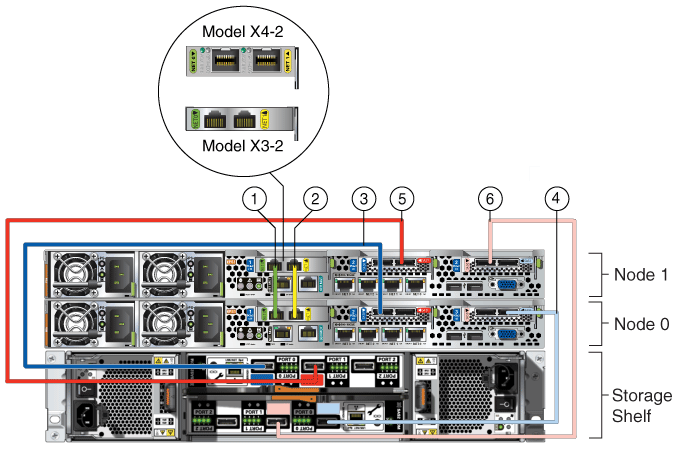
Description of "Figure 3-2 Interconnects and Cables for Single Storage Shelf on Oracle Database Appliance X4-2 and X3-2"
Table 3-2 Description of Callouts for Cabling Oracle Database Appliance X4-2 or X3-2 With Single Storage Shelf
| Callout Number | Description |
|---|---|
|
1 |
Green Cat 6 cable (Oracle Database Appliance X3-2) or green-labelled twinax cable (Oracle Database Appliance X4-2):
|
|
2 |
Yellow Cat 6 cable (Oracle Database Appliance X3-2) or yellow-labeled twinax cable (Oracle Database Appliance X4-2)
|
|
3 |
Dark blue SAS cable:
|
|
4 |
Light blue SAS cable:
|
|
5 |
Dark red SAS cable:
|
|
6 |
Light red SAS cable:
|
Caution:
Do not attach cables to ethernet ports in the I/O modules labeled "SERVICE ONLY" when cabling the system. These ports are intended for use by service engineers only. You must use Oracle Appliance Manager to manage Oracle Database Appliance storage.
Note:
The back panel of each node contains three PCIe generation 3 terminal slots, with two sockets in each slot. The PCIe slots are labeled X PCIe3, where X is the PCIe slot number.
Cabling Oracle Database Appliance to Connect to Fiber Public Networks (Optional)
You can configure X5-2, X4-2, and X3-2 appliances to use fiber connections for the public network.
For Oracle Database Appliance X4-2 and X5-2 installations, if you want to use fiber connections between Oracle Database Appliance and your public network, then you must cable the interconnect by using the green and yellow copper ports (onboard ports net0 and net1). The green and yellow Category 6 (Cat 6) interconnect cables for these ports ship with the base system.
Oracle Database Appliance X4-2 includes fiber ports as part of the base configuration. However, for Oracle Database Appliance X5-2, if you want to use a fiber port connection, then you must replace the InfiniBand cards with 10 GbE SFP+ (fiber) cards. Fiber ports do not exist in the base configuration for X5-2. You must re-image Oracle Database Appliance X5-2 after you replace the PCIe cards. After you replace the cards, Oracle Database Appliance auto-detects the network configuration changes.
Caution:
If you replace the InfiniBand interconnect cards on Oracle Database Appliance X5-2, then you disable the Oracle Database Appliance in-memory fault tolerance feature. Also, interconnect bandwidth is reduced from 40 GB to 10 GB. If you have Oracle RAC databases, then you may experience slower intercommunication speeds, depending on the system workload.
In the following figure, callouts 1 and 2 show how to cable the interconnect between Node 1 and Node 0 using the green and yellow copper ports (onboard ports net0 and net1) to use a fiber public network. Note that the illustration shows the rear panel of an Oracle Database Appliance X4-2. The rear panel of the Oracle Database Appliance X5-2 is slightly different, but the interconnect cabling is the same.
Figure 3-3 Interconnects When Using Fiber Connections to the Public Network on Oracle Database Appliance Models X5-2 and X4-2
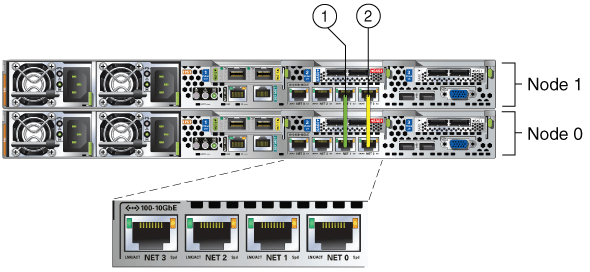
Description of "Figure 3-3 Interconnects When Using Fiber Connections to the Public Network on Oracle Database Appliance Models X5-2 and X4-2"
The following sections show the cabling options for 10 GbE SFP+ PCI cards.
Fiber Cables
For optical cables, you must purchase either Short Range (SR) or Long Range (LR) SFP+ transceivers for each of the network ports, and then plug in the appropriate optical cable. Currently, Oracle sells both the SR and LR SFP+ transceivers. In addition to these transceivers, you must purchase the appropriate LC-LC terminated fiber optic cables from a third-party vendor.
| Name | Oracle Sun Part Number |
|---|---|
|
10 GbE Transceiver SR (SFP+) |
X2129A-N |
|
10 GbE Transceiver LR (SFP+) |
X5562A-Z |
Copper Cables
You can purchase the following copper cables from Oracle Sun. These cables have built-in SFP+ connectors:
| Name | Length | Oracle Sun Part Number |
|---|---|---|
|
TwinAx 1m |
1m |
X2130-1M |
|
TwinAx 3m |
3 m |
X2130-3M |
|
TwinAx 5m |
5m |
X2130-5M |
Attaching a Storage Expansion Shelf to Oracle Database Appliance
Review these topics to install and cable a storage expansion shelf for Oracle Database Appliance.
Topics:
- About Attaching and Cabling Storage Shelves
Review these options and best practices for adding storage shelves for Oracle Database Appliance X3-2, X4-2 and X5-2. - Installing and Cabling a Storage Expansion Shelf
Use this procedure to install and cable a storage expansion shelf for Oracle Database Appliance
About Attaching and Cabling Storage Shelves
Review these options and best practices for adding storage shelves for Oracle Database Appliance X3-2, X4-2 and X5-2.
Storage Shelf Options for Oracle Database Appliance X3-2, X4-2 and X5-2
Oracle Database Appliance models X3-2, X4-2, and X5-2 can be shipped with one or two storage shelves. You can obtain the second shelf at a later time to double your storage capacity.
If you originally deployed Oracle Database Appliance with one storage shelf, then you can add a storage expansion shelf at any time without having to shut down your databases or applications.
Best Practice Guidelines for Adding Storage Expansion Shelves
Oracle recommends that you add a storage expansion shelf when you have relatively little activity on your databases. When the system discovers the new storage, Oracle ASM automatically rebalances the disk groups. The rebalance operation may degrade database performance until the operation completes.
Caution:
Review cabling instructions to ensure that you have carried out cabling correctly. Incorrect connections can cause data loss when adding a storage expansion shelf to Oracle Database Appliance with existing databases.
Do not attach cables to Ethernet ports in the I/O modules labeled "SERVICE ONLY" when cabling the system. These ports are intended for use by service engineers only.
Installing and Cabling a Storage Expansion Shelf
Use this procedure to install and cable a storage expansion shelf for Oracle Database Appliance
-
Place the storage expansion shelf below your Oracle Database Appliance, if possible, or else close enough to connect the provided cables.
The storage expansion shelf normally sits at the bottom of Oracle Database Appliance, beneath the storage shelf. However, because racks should always be provisioned from the bottom up, that space may be unavailable. In that case, to avoid re-rack mounting the entire system, you can position the storage expansion shelf above the server nodes, or in a different, but adjacent, rack.
-
Install the extension storage shelf in exactly the same manner as the original storage shelf.
-
Use the figures in this topic to assist you to cable the storage expansion shelf for your Oracle Database Appliance model.
Caution:
Incorrect connections can cause data loss when adding a storage expansion shelf to Oracle Database Appliance with existing databases.
-
Attach the supplied power cords. Refer to the section "Attaching Power Cords and Initializing Components" to obtain information and see figures showing how to attach power cords.
Figures Showing How to Cable a Storage Expansion Shelf
The following figures show you how to insert the required cables into the storage expansion shelf of Oracle Database Appliance. The cables for the two nodes and the original storage shelf are included in the illustration for reference.
The cables are color-coded. Match the colors of the labels at the ends of each cable with the colored line shown in the following illustration. Also match the cable colors to the background colors of the socket identification labels.
You can also use the callouts in the diagrams and the callout table that follows the diagrams to identify the cables and ports. Because all cables with the same terminations are interchangeable, you can ignore the color coding.
Note:
The back panel of each node contains three PCIe generation 3 terminal slots, with two sockets in each slot. The PCIe slots are labeled X PCIe3, where X is the PCIe slot number. Review the callout table that follows the figures for more information.
Figure 3-4 Cables for Storage Expansion Shelf on Oracle Database Appliance X5-2
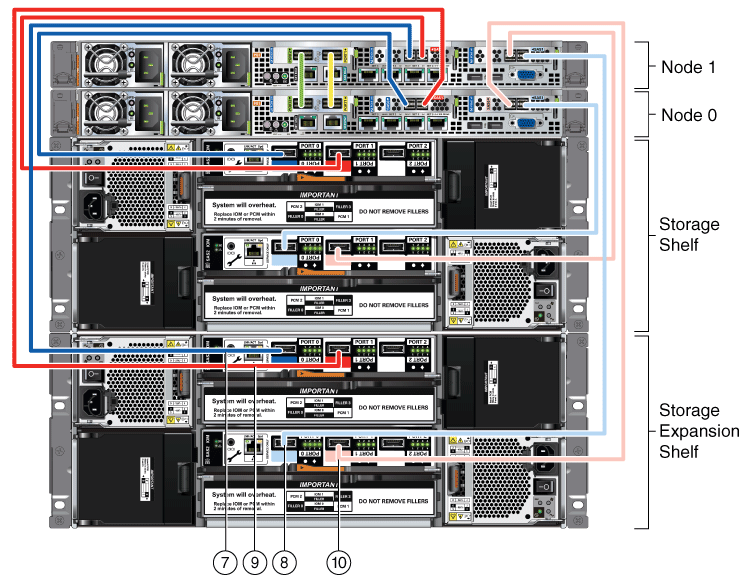
Description of "Figure 3-4 Cables for Storage Expansion Shelf on Oracle Database Appliance X5-2"
Figure 3-5 Cables for Storage Expansion Shelf on Oracle Database Appliance X3-2 and X4-2
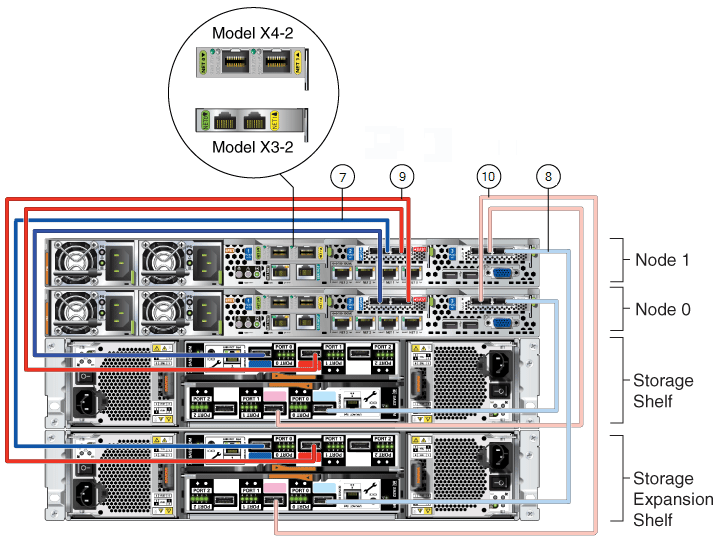
Description of "Figure 3-5 Cables for Storage Expansion Shelf on Oracle Database Appliance X3-2 and X4-2"
The cables identified with callout numbers in the preceding figures are included with each shipped Oracle Database Appliance storage expansion shelf. These cables are all black, but have colored labels at each end that match the references to cable colors in the text and the label colors on the back panels.
Table 3-3 Description of Callouts for Cabling Oracle Database Appliance Storage Expansion Shelf
| Callout Number | Description |
|---|---|
|
7 |
Dark blue SAS cable:
|
|
8 |
Light blue SAS cable:
|
|
9 |
Dark red SAS cable:
|
|
10 |
Light red SAS cable:
|
Caution:
Do not attach cables to Ethernet ports in the I/O modules labeled "SERVICE ONLY" when cabling the system. These ports are intended for use by service engineers only.
See Also:
Attaching Power Cords and Initializing Components
To review information about installing optional components for Oracle Database Appliance, see the section "Optional Component Installation" in Chapter 4 of Oracle Database Appliance Owner’s Guide.
Attaching Peripheral Devices
Complete this task if you have direct access to Oracle Database Appliance, and you intend to use a locally connected monitor, keyboard and mouse.
Oracle Database Appliance is not equipped with human-computer interface devices, such as a monitor or keyboard. If you want to log in locally, instead of through a network, then you must attach interface devices to Node 0.
Attach a monitor to the graphics card port, and attach a keyboard and a mouse to the USB ports on Node 0. Refer to the figure for your monitor, and to the callout table to identify the ports. The figure "Peripheral Device Connections for Oracle Database Appliance (Node 0) on X3-2, X4-2" shows Oracle Database Appliance models X3-2 and X4-2. For X5-2, the rear panel is slightly different; however, the peripheral device connections are the same as X3-2 and X4-2. The figure "Peripheral Device Connections for Oracle Database Appliance Version 1 (Node 0)" shows connection points for Oracle Database Appliance Version 1.
Figure 3-6 Peripheral Device Connections for Oracle Database Appliance (Node 0) on X3-2, X4-2

Description of "Figure 3-6 Peripheral Device Connections for Oracle Database Appliance (Node 0) on X3-2, X4-2"
Figure 3-7 Peripheral Device Connections for Oracle Database Appliance Version 1 (Node 0)

Description of "Figure 3-7 Peripheral Device Connections for Oracle Database Appliance Version 1 (Node 0)"
In the figures, callout 1 identifies the ports for the keyboard and mouse. Callout 2 identifies the monitor port.
Table 3-4 Peripheral Device Connections for Oracle Database Appliance
| Callout Number | Description |
|---|---|
|
1 |
USB ports for the keyboard and mouse |
|
2 |
Graphics card port for the monitor |
First Startup of Oracle Database Appliance
Use this procedure to start up either a newly-installed Oracle Database Appliance, or to start up the appliance after you power it down, or after you add new hardware, such as a storage expansion shelf.
To ready Oracle Database Appliance for the powering on the first time, you need to attach all of the required power cords, which differ between models and options, and confirm that initialization completes successfully. You can then start up the system by switching on the process server nodes.
Topics:
- Attaching Power Cords and Initializing Components
Refer to the figure for your appliance and the callouts table to identify where to attach power cords for Oracle Database Appliance models with external storage shelves. - Powering On Oracle Database Appliance the First Time
Use this procedure to power on Oracle Database Appliance. - Defining Your Public Network Interface Type (X4-2)
For Oracle Database Appliance X4-2, after system startup, you are prompted to indicate if you are using copper or fiber network interfaces for your public network.
Attaching Power Cords and Initializing Components
Refer to the figure for your appliance and the callouts table to identify where to attach power cords for Oracle Database Appliance models with external storage shelves.
Note:
In the callouts, the two separate AC circuits required for N+1 redundancy are denoted by AC1 and AC2.
Caution:
Before you insert any power cables, ensure that the power supply On/Off switch on the storage shelf is in the Off position. If a storage expansion shelf is installed, then ensure that the power supply switches on both storage shelves are in the Off position.
When you plug in power cords, ensure that the electrical outlets providing the power are grounded before plugging in the power cords.
Figure 3-8 Power Cord Connections on Oracle Database Appliance X5-2

Description of "Figure 3-8 Power Cord Connections on Oracle Database Appliance X5-2"
Figure 3-9 Power Cord Connections on Oracle Database Appliance X4-2 and X3-2
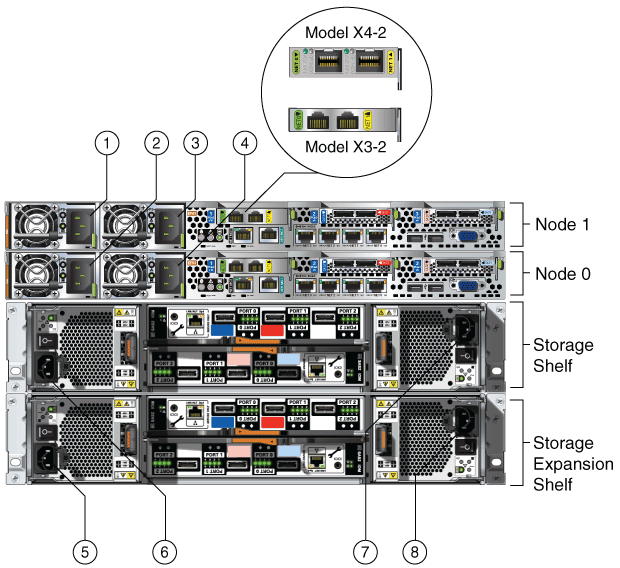
Description of "Figure 3-9 Power Cord Connections on Oracle Database Appliance X4-2 and X3-2"
If you use only a single AC circuit, then connect both power cords for each component to that circuit. If you want to maintain N+1 power supply redundancy, then use two separate AC circuits. Connect one power cord from each AC circuit into each component: Node 0, Node 1, and the storage shelf or shelves. Refer to the callout table below the images for the labels for each callout in the image.
Table 3-5 Electrical Power Cord Connections for Oracle Database Appliance with Storage Shelves
| Callout Number | Component | AC Circuit |
|---|---|---|
|
1 |
Node 1 |
AC1 |
|
2 |
Node 0 |
AC1 |
|
3 |
Node 1 |
AC2 |
|
4 |
Node 0 |
AC2 |
|
5 |
Storage expansion shelf (Not required for single storage shelf implementations) |
AC1 |
|
6 |
Storage shelf |
AC1 |
|
7 |
Storage shelf |
AC2 |
|
8 |
Storage expansion shelf (Not required for single storage shelf implementations) |
AC2 |
Oracle Database Appliance Version 1 hardware has only one power socket for each node. The power sockets are at the lower left corner of the rear panels.
For more information about cabling with the supplied Cable Management Arm, refer to the Oracle Database Appliance Owner’s Guide.
Powering On Oracle Database Appliance the First Time
Use this procedure to power on Oracle Database Appliance.
Before starting to power on the appliance, make sure that all of the required power cables are attached to both Oracle Database Appliance nodes, and to all storage shelves, if they are included with your appliance.
Note:
After you connect power cords, the green SP OK light-emitting diode (LED) lights blink for a few minutes, and then turn to steady ON. The cooling fans also may turn on. However, these events do not indicate that the system is started. You must complete all of the steps in this section to turn on the appliance properly. Read through the entire section to understand the sequence required for initial system startup.
Defining Your Public Network Interface Type (X4-2)
For Oracle Database Appliance X4-2, after system startup, you are prompted to indicate if you are using copper or fiber network interfaces for your public network.
After you power on Oracle Database Appliance X4-2 for the first time, a short script runs on each node. Use an attached keyboard to answer questions that the script displays on the local monitor.
Note:
This procedure applies only to Oracle Database Appliance X4-2. When you power on 5-2 for the first time, the system automatically defines your public network interface based on the interconnect. On Oracle Database Appliance X5-2, the InfiniBand network is used for the interconnect if InfiniBand cards are used. If InfiniBand cards are replaced with 10 GbE SFP+ (fiber) cards, then the onboard 10GBase-T (Copper) ports are used for the interconnect.
-
Oracle Database Appliance displays the following message to prompt you to indicate your public interface connection type:
Do you want to use Fiber or Copper card for public network? Please Choose [C]opper or [F]iber.If you are connecting to a copper-based public network, then enter
C. If you are connecting to a fiber-based public network, then enterF. The script then prompts you to confirm your choice. -
Proceed with system configuration.
If you make a mistake, or if you want to change your public interface type later, then you can do the following to change your public network interface type:
-
Log into Node 0 as root.
-
Run the following script:
/opt/oracle/oak/lib/setupX4network.pl -
Repeat steps a and b on Node 1.
-
Note:
If you have already deployed the End-User Bundle (Bare Metal installation) or the ODA_BASE template (Virtualized Platform installation), then you must redeploy that software after running setupX4network.pl.
Configuring Oracle Integrated Lights Out Manager
Configure Oracle Integrated Lights Out Manager (Oracle ILOM) to manage Oracle Database Appliance independent of the operating system.
Oracle ILOM provides alternate ways to restart and troubleshoot Oracle Database Appliance.
You must set up the following items first to configure Oracle ILOM:
-
A name and IP address
-
A password to replace the default Oracle ILOM password
-
Access to a management network, using an assigned netmask
-
An Ethernet cable connected from the NET MGT port to the management network
In the default configuration, Dynamic Host Configuration Protocol (DHCP) is enabled in Oracle ILOM and the DHCP server automatically assigns network settings. To determine the IP address or host name assigned by the DHCP server, use the network tools provided with the DHCP server.
If you do not use DHCP, then use the custom option in Oracle Database Appliance Manager Configurator to assign IP addresses and host names to Oracle ILOM when you deploy your database.
Note:
If you have not enabled DHCP, then you must complete Oracle Database Appliance configuration to access Oracle ILOM.
To connect to the Oracle ILOM, use one of the following two methods:
-
Log in using a web interface by completing these steps:
-
Using a client system's browser, enter the IP address or host name assigned by DHCP into the browser address field and press Enter.
-
At the login page, enter the default user name,
rootand the default password,changeme.The Oracle ILOM web interface appears.
-
-
Log in using a command line interface (CLI) by completing these steps:
-
Using a client system, establish a secure shell (SSH) connection by entering the following on the command line:
ssh -l root sp_ip_addresswhere
sp_ip_addressis the IP address assigned by DHCP. -
Enter the default user name,
root, and the default password,changeme.The Oracle ILOM CLI prompt appears.
-
Attaching Power Cords and Initializing Components
Refer to the figure for your appliance and the callouts table to identify where to attach power cords for Oracle Database Appliance models with external storage shelves.
Note:
In the callouts, the two separate AC circuits required for N+1 redundancy are denoted by AC1 and AC2.
Caution:
Before you insert any power cables, ensure that the power supply On/Off switch on the storage shelf is in the Off position. If a storage expansion shelf is installed, then ensure that the power supply switches on both storage shelves are in the Off position.
When you plug in power cords, ensure that the electrical outlets providing the power are grounded before plugging in the power cords.
Figure 3-12 Power Cord Connections on Oracle Database Appliance X5-2

Description of "Figure 3-12 Power Cord Connections on Oracle Database Appliance X5-2"
Figure 3-13 Power Cord Connections on Oracle Database Appliance X4-2 and X3-2

Description of "Figure 3-13 Power Cord Connections on Oracle Database Appliance X4-2 and X3-2"
If you use only a single AC circuit, then connect both power cords for each component to that circuit. If you want to maintain N+1 power supply redundancy, then use two separate AC circuits. Connect one power cord from each AC circuit into each component: Node 0, Node 1, and the storage shelf or shelves. Refer to the callout table below the images for the labels for each callout in the image.
Table 3-7 Electrical Power Cord Connections for Oracle Database Appliance with Storage Shelves
| Callout Number | Component | AC Circuit |
|---|---|---|
|
1 |
Node 1 |
AC1 |
|
2 |
Node 0 |
AC1 |
|
3 |
Node 1 |
AC2 |
|
4 |
Node 0 |
AC2 |
|
5 |
Storage expansion shelf (Not required for single storage shelf implementations) |
AC1 |
|
6 |
Storage shelf |
AC1 |
|
7 |
Storage shelf |
AC2 |
|
8 |
Storage expansion shelf (Not required for single storage shelf implementations) |
AC2 |
Oracle Database Appliance Version 1 hardware has only one power socket for each node. The power sockets are at the lower left corner of the rear panels.
For more information about cabling with the supplied Cable Management Arm, refer to the Oracle Database Appliance Owner’s Guide.
Configuring an Initial Network Connection
Configure a temporary network configuration framework to build your network information during deployment.
To manage your Oracle Database Appliance deployment across a network, you must configure an initial network connection. Use this network to transfer deployment software to Oracle Database Appliance.
If you have physical access to your Oracle Database Appliance, then you can use a USB storage device to transfer deployment software to the appliance. In that case, you do not need to set up an initial network configuration.
Note:
The initial network configuration is temporary. It is replaced during the final image deployment.
Caution:
Oracle recommends using the oakcli configure firstnet command only one time on Oracle Database Appliance. Subsequent use after configuring the initial network can cause unpredictable changes to your network settings.
Validating Oracle Appliance Manager Software Version
Before deploying Oracle Database Appliance, you should have the current version of the Oracle Appliance Manager software installed.
Run the following command to find the installed version on your appliance:
oakcli show version
Confirm that you have the most current version of Oracle Appliance Manager.

